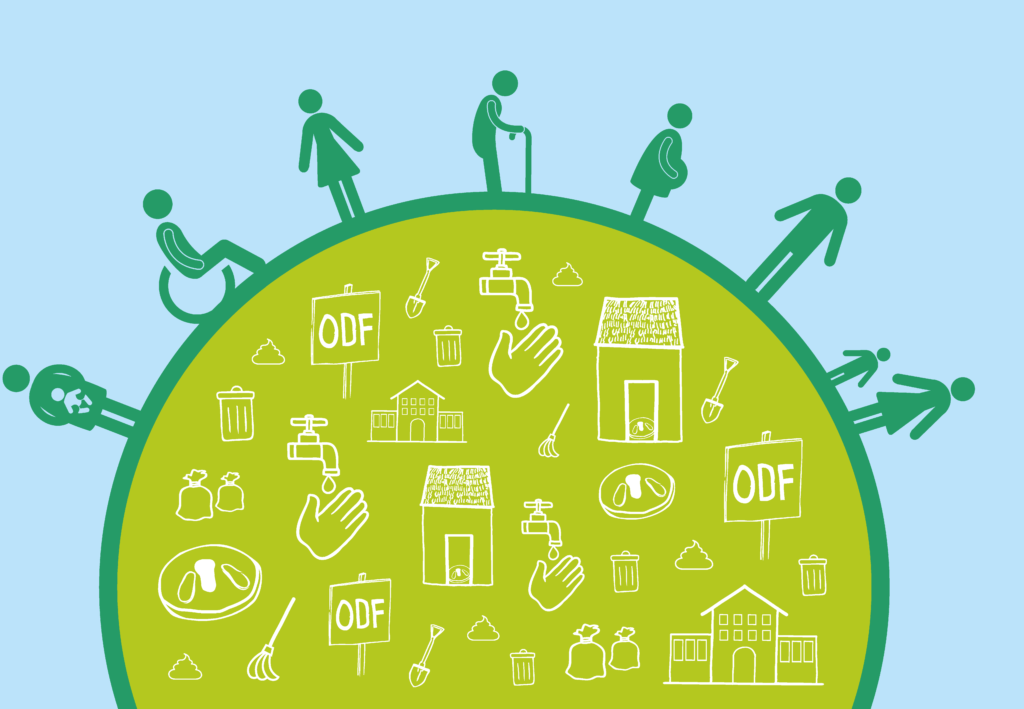In this blog we reflect on the continued relevance of the phased approach, outlining key lessons learnt since 2016 and addressing long-standing challenges.
In 2016 A phased approach to rural sanitation development was published in the book Sustainable Sanitation for All. In this chapter we aimed to move beyond open defecation free (ODF) outcomes and towards promoting progressive solutions that we had either seen in action, or that we thought most likely to work, at scale in low-income, low-capacity settings.
In 2015, Community Led Total Sanitation (CLTS) had been in full flow for several years – ODF achievements were spreading and growing, and several countries (notably Bangladesh and Nepal) were working towards 100% ODF status. But it was already clear that ODF was not enough – in some cases, ODF status was short-lived, or not fully inclusive; and in others people wanted and needed higher levels of service, including more durable and attractive facilities, and more safely managed and sustainable services.
Phased approach to rural sanitation development
The phased approach to rural sanitation development was designed to respond to two important questions:
- How to progress sanitation after communities achieve ODF status?
- How best to achieve multiple sanitation and environmental health objectives?
In 2023, these questions remain relevant: the Sustainable Development Goal (SDG) sanitation target 6.2 has highlighted the need for sanitation services to be safely managed – both safely managed over time, and safely managed throughout the full sanitation service chain. There is also recognition that, if we really want to improve public health and wellbeing, we cannot ignore wider environmental health outcomes in rural communities.
A phased approach provides a practical solution to these challenges: you don’t have to achieve everything at once – you can break down the achievement of multiple outcomes into intermediate steps, and prioritise outcomes based on their public health (and other) benefits and on the relative ease and reliability of achievement. A phased approach also encourages periodic assessments of household and community-wide outcomes as communities progress towards higher level outcomes, so sustainability checks are built into the process.
This approach also delivers regular encouragement through the achievement and recognition of intermediate outcomes, while allowing more progressive and able communities to progress directly to higher outcomes (and establish models of success for other communities to emulate). It also allows more targeted finance and support to be provided in each phase, as new challenges and requirements are addressed.
While we often focus on toilets and hand hygiene, other practices such as child excreta disposal, food hygiene, safe water management, animal health and animal waste management can be equally important to public health and well-being. But we usually avoid promoting more than a couple of behaviour changes at once, in order to keep the process simple, and retain a focus on the priority outcomes. A phased approach provides a practical way of achieving a series of behaviour changes through phased and prioritised activities that allow outcome achievement to be more easily managed and monitored.
Lessons learned since 2016
By 2016, phased approaches to rural sanitation development had already been included in the 2012 Timor-Leste National Basic Sanitation Policy, were being implemented in the Philippines, and had been recently introduced in Ghana. Since then, several other countries have introduced or formalised phased policies or protocols:
- 2017 Nepal: Nepal Total Sanitation Guideline (English translation of guidelines)
- 2018 Zambia: Open Defecation Free Zambia Strategy 2018-2030
- 2019 Philippines: Administrative Order on Guidelines for the Implementation of the Philippine Approach to Sustainable Sanitation (PhASS)
- 2022 Kenya: Kenya Rural Sanitation and Hygiene (RuSH) Protocol
SNV Nepal adopted the Nepal Total Sanitation guidelines in its DFID-supported Sustainable Sanitation and Hygiene for All (SSH4A) programme, and began work towards the higher outcomes in wards and districts that had already been certified ODF. Total Sanitation status required the verification of 21 different outcomes, which made it difficult for most communities to achieve. As a result, SNV decided to focus on smaller sub-villages, working with the most progressive ones to figure out how to achieve these multiple outcomes among smaller populations. Progress has been slow, with the main lesson being that intermediate phases need to be simple and achievable (i.e. including fewer outcomes), otherwise both implementers and communities begin to lose hope and motivation.
Another lesson is that a phased sanitation policy alone is not enough to bring about change. Zambia and the Philippines introduced phased sanitation strategies and guidelines in 2018 and 2019, but these were not backed by investment programmes or large-scale implementation. As a result, progress towards the higher- level outcomes has been slow, with dependence on donor programmes that support the phased approach (rather than the more large-scale and long-term government funding that is required for national impact).
In 2016, the Kenya Ministry of Health launched the Kenya Environmental Sanitation and Hygiene Policy (KESHP) 2016-2030. This ambitious and comprehensive policy required that by 2030 all Kenyans should live in an ODF environment, with universal access to improved sanitation, and a clean and healthy environment for all Kenyans through waste management and pollution control.
In 2020, UNICEF supported the Kenya Ministry of Health to develop an updated Rural Sanitation and Hygiene Protocol that would promote the achievement of these policy objectives through a phased protocol with the following grades:
- G1 ODF (no OD, use of clean toilets, handwashing, safe child excreta disposal)
- G2 Safe & sustainable (durable toilets with safe containment, safe food & water, safe management of animals and animal wastes)
- G3 Clean & healthy (safely managed sanitation, safe waste management, personal hygiene)
The Kenya Rural Sanitation and Hygiene (RuSH) Protocol was launched by the Ministry of Health in late 2022, with several donors lined up to support implementation. Given some challenging contexts, some stakeholders felt that the protocol was too ambitious and too complex for rural Kenya. However, when the draft protocol was reviewed by a group of County Public Health Officers in late 2021, they saw it as a practical approach to the achievement of the range of environmental health outcomes that the counties were already working on through multiple sector programmes (WASH, health, nutrition, food security, agriculture, livestock). The CPHOs felt that this phased outcome framework would clarify community goals, facilitate progress tracking, and encourage the different sector teams to work together, all of which they fully supported!
Addressing the challenges
Some stakeholders still question the benefits of a phased approach to sanitation development: the main concern being that households may build toilets that will shortly need to be improved – that is, first a home-made CLTS toilet; then an improved toilet; and finally a safely managed toilet. Surely it would better to promote a safely managed toilet from the start, and avoid any wasted time and investment?
Our response is that, in low-income and resource-scarce settings, it is hard to persuade people to use any form of toilet! A phased approach allows the rapid development of higher levels of service (where possible), while also recognising that some people take longer to change their behaviour, longer to invest in a good toilet, and longer to learn how to safely manage their sanitation facilities and services. In our opinion, investing some time and providing some structure and long-term support for this process of habit formation, home improvement and sector learning is a highly cost-effective way of encouraging more sustainable and appropriate sanitation solutions.







